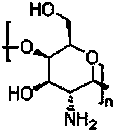Preparation method of crosslinked chitosan/gelatin composite porous scaffold
A technology of cross-linking chitosan and porous scaffolds, which is applied in medical science, prosthesis and other directions, can solve problems such as weak mechanical strength, and achieve the effects of good mechanical properties, good affinity, and simple and convenient process
- Summary
- Abstract
- Description
- Claims
- Application Information
AI Technical Summary
Problems solved by technology
Method used
Image
Examples
Embodiment 1
[0023] The methanol suspension of 2% chitosan, the methanol suspension of gelatin and the methanol solution of silane coupling agent KH-560 were configured respectively in mass percentage;
[0024] Blend the above methanol suspension of chitosan, gelatin in methanol and silane coupling agent KH-560 in methanol at a mass ratio of 35:35:30, heat up to 70°C, stir for 3 hours, and filter with suction , repeatedly washing with anhydrous methanol until the unreacted silane coupling agent KH-560 is washed away, and after vacuum drying at 60°C for 24 hours, a cross-linked chitosan / gelatin composite material is obtained;
[0025] With above-mentioned cross-linked chitosan / gelatin composite material, be dissolved in 100g distilled water, prepare the aqueous solution that mass percent is 1% cross-linked chitosan / gelatin composite material, defoam, obtain the cross-linked chitosan after deaeration Aqueous solutions of sugar / gelatin composites;
[0026] Pour the above degassed cross-linke...
Embodiment 2
[0029] Same as Example 1, but the methanol suspension of chitosan, the methanol suspension of gelatin and the concentration of the methanol solution of silane coupling agent KH-560 in step (1) are all changed from 2% to 3%, other unchanged .
Embodiment 3
[0031] Same as Example 1, but the methanol suspension of chitosan, the methanol suspension of gelatin and the concentration of the methanol solution of silane coupling agent KH-560 in step (1) are all changed from 2% to 1%, and others remain unchanged .
PUM
 Login to View More
Login to View More Abstract
Description
Claims
Application Information
 Login to View More
Login to View More - R&D
- Intellectual Property
- Life Sciences
- Materials
- Tech Scout
- Unparalleled Data Quality
- Higher Quality Content
- 60% Fewer Hallucinations
Browse by: Latest US Patents, China's latest patents, Technical Efficacy Thesaurus, Application Domain, Technology Topic, Popular Technical Reports.
© 2025 PatSnap. All rights reserved.Legal|Privacy policy|Modern Slavery Act Transparency Statement|Sitemap|About US| Contact US: help@patsnap.com



